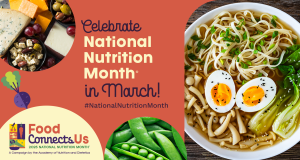
by Amy Mullins, PhD, RDN | Apr 2, 2025
Inflammation is a natural response of the body’s immune system, designed to protect us from infection and injury. However, chronic inflammation is a complex condition characterized by a persistent and low-grade inflammatory response that can lead to various diseases including arthritis, diabetes, cardiovascular disease, neurodegenerative diseases, and cancer.

Diet contributes to chronic inflammation in the body.
Chronic inflammation can be caused by various factors, including:
- Genetic predisposition: Certain genetic mutations can affect the body’s inflammatory response, making it more prone to chronic inflammation.
- Environmental factors: Exposure to pollutants, stress, and other environmental stressors can trigger chronic inflammation.
- Lifestyle factors: Sedentary lifestyle, smoking, and poor diet can contribute to chronic inflammation.
While genetics, environmental, and lifestyle factors contribute to chronic inflammation, diet is a controllable risk factor that plays a significant role in its development and exacerbation. There are many common foods in the American diet that are responsible for promoting inflammation in the body.
Some of the most common pro-inflammatory foods include:
- Processed and Packaged Meats: hot dogs, processed deli meats, bacon, and sausage. This includes meat that has been smoked, cured, salted, dried, or canned.
- Refined Carbohydrates: white bread, bakery foods (such as cookies, cakes, and pastries), processed cereals, white rice and pasta.
- Fried Foods: French fries, fried chicken, fried fish, fried vegetables, and fried sweets such as doughnuts.
- Processed and High-Sugar Foods & Beverages: candy, chocolate, soda, energy drinks, and fruit drinks.
- Foods High in Saturated and Trans Fats: red meat (such as beef and pork), processed meats, whole milk, cheese, ice cream, butter, coconut oil, and partially hydrogenated oils (such as margarine and processed snack foods).
- Vegetable & Seed Oils High in Omega-6 Fatty Acids: canola oil, corn oil, soybean oil, peanut oil, safflower, and sunflower oils are often used in frying and production of ultra-processed or convenience foods. Also high in omega-6 fatty acids are mayonnaise and most salad dressings. Although omega-6 fatty acids are essential in the diet, excess intake of omega-6 oils can promote inflammation in the body when not balanced with enough omega-3 fatty acids.
Why do these foods contribute to chronic inflammation?
- High sugar and refined carbohydrate content: Consuming high amounts of sugar and refined carbohydrates can contribute to insulin resistance, a precursor to chronic inflammation.
- Saturated and trans fats: These fats can promote inflammation by altering the body’s fatty acid composition and disrupting the balance of omega-6 and omega-3 fatty acids.
- Presence of AGEs: Foods cooked at high temperatures, such as charred meats and fried foods, contain advanced glycation end products (AGE), which can cause oxidative stress and stimulate inflammation by binding to specific receptors on immune cells.
- Processed and high-sodium content: Processed foods often contain high amounts of sodium, which can lead to inflammation and cardiovascular disease.
- Lack of essential nutrients: Many pro-inflammatory foods are low in essential nutrients, leading to nutrient deficiencies that can contribute to inflammation.
To reduce chronic inflammation, focus on limiting or avoiding pro-inflammatory foods and incorporating more anti-inflammatory foods and nutrients into the diet.
Nutrients That Can Help Reduce Inflammation
- Omega-3 fatty acids: These essential fatty acids can help reduce inflammation and promote healing.
- Vitamin D: Vitamin D deficiency has been linked to increased inflammation.
- Antioxidants: Antioxidants, such as vitamins C and E, can help reduce oxidative stress and inflammation.
- Probiotics: Probiotics can help maintain a healthy gut microbiome, which is essential for reducing inflammation.
Foods that Reduce Inflammation
- Leafy Greens: Leafy greens like spinach, kale, and collard greens are rich in antioxidants and flavonoids, which can help reduce inflammation.
- Fatty Fish: Fatty fish like salmon, sardines, and mackerel are rich in omega-3 fatty acids, which can help reduce inflammation.
- Berries: Berries like blueberries, raspberries, and strawberries are rich in antioxidants and flavonoids, which can help reduce inflammation.
- Nuts and Seeds: Nuts and seeds like walnuts, chia seeds, and flaxseeds are rich in omega-3 fatty acids and antioxidants, which can help reduce inflammation.
- Turmeric: Turmeric contains a compound called curcumin, which has potent anti-inflammatory and antioxidant properties.
- Ginger: Ginger has anti-inflammatory compounds called gingerols and shogaols, which can help reduce inflammation.
- Green Tea: Green tea is rich in antioxidants and polyphenols, which can help reduce inflammation.
- Olive Oil: Olive oil is rich in antioxidants and anti-inflammatory compounds, which can help reduce inflammation.
What can you do to improve your diet? Here are some strategies to help you get started:
- Choose whole, unprocessed foods: Focus on whole grains, fruits, vegetables, lean proteins, and healthy fats.
- Stay hydrated with water: Replace sugary drinks with water. Adequate hydration can help to reduce inflammation and oxidative stress.
- Cook at home: Prepare meals using fresh ingredients to control the amount of sugar, salt, and unhealthy fats in your diet.
- Read labels: Be aware of the ingredients and nutritional content of packaged foods, and choose options that are lower in added sugars, saturated fats, and sodium.
- Gradually transition to a balanced diet: Replace pro-inflammatory foods with anti-inflammatory ones and gradually adjust your diet over time.
By making informed choices about the foods we eat and incorporating anti-inflammatory foods into our diet, we can reduce our risk of chronic inflammation and promote overall health and well-being.
References:
During the preparation of this work the author used the AI tool, NaviGator. After using this tool/service, the author reviewed and edited the content as needed and takes full responsibility for the content of the publication.
Photo source: https://stock.adobe.com/1277005967 and /532657650

by Samantha Kennedy | Mar 28, 2025
In today’s credit-centric economy, maintaining a healthy credit score is more crucial than ever. One of the most effective ways to ensure good credit health is by regularly reviewing your annual credit reports from all three major credit reporting agencies: Equifax, Experian, and TransUnion. This practice not only helps you stay informed about your financial status but also protects you from potential fraud and errors that could negatively impact your credit score.
Understanding Your Credit Report
A credit report is a detailed record of your credit history, including information about credit accounts, payment history, and any public records such as bankruptcies or liens. Each of the three major credit reporting agencies collects and maintains this information independently, which means that your credit report from Equifax may differ slightly from the one provided by Experian or TransUnion. By reviewing all three reports, you get a comprehensive view of your credit history and can identify any discrepancies or inaccuracies.
Detecting Errors and Fraud
Errors on credit reports are more common than is often thought. According to a study by the Federal Trade Commission, one in five consumers has an error on at least one of their credit reports. These errors can range from incorrect personal information to inaccurate account details or even accounts that do not belong to you. By reviewing your credit reports annually, you can spot these errors early and take steps to correct them before they cause significant damage to your credit score.
In addition to errors, reviewing your credit reports can help you detect signs of identity theft. If you notice unfamiliar accounts or inquiries on your report, it could be a sign that someone has stolen your personal information and is using it to open credit accounts in your name. Early detection is key to minimizing the damage caused by identity theft, and regularly checking your credit reports is one of the best ways to catch fraudulent activity quickly.
Improving Your Credit Score
Your credit score is a numerical representation of your creditworthiness, and it plays a significant role in your ability to obtain loans, credit cards, and even housing. By reviewing your credit reports, you can identify areas where you can improve your credit score. For example, you might notice that you have high credit card balances or a history of late payments. By addressing these issues, you can work towards improving your credit score over time.

Reviewing a copy of your credit report from each credit reporting agency at least once a year is a great way to discover errors that may negatively impact your credit worthiness. (Adobe Stock photo)
Taking Advantage of Free Reports
Under the Fair Credit Reporting Act (FCRA), you are entitled to one free credit report from each of the three major credit reporting agencies every 12 months. In 2024, this changed to free weekly copies of your credit report from each agency. This means you can access your credit reports from Equifax, Experian, and TransUnion at no cost, giving you the opportunity to review your credit history without any financial burden. To obtain your free reports, you can visit AnnualCreditReport.com, the only authorized website for free credit reports. You will never be asked to pay for your credit report on this site. If you are, you are on the wrong site.
Reviewing your credit report from all three major credit reporting agencies is a vital step in maintaining your financial health. By staying informed about your credit history, detecting errors and fraud early, and taking steps to improve your credit score, you can ensure that you are in the best possible position to achieve your financial goals. Don’t wait until it’s too late—make reviewing your credit reports a regular part of your financial routine.
An Equal Opportunity Institution

by Claire Davis | Mar 1, 2025
As the warmer months approach, many of us can’t wait to spend time outdoors with our loved ones, enjoying the sunshine and making lasting memories. Whether you’re planning a family vacation to the beach or mountains, a backyard BBQ with friends and family, or a simple picnic in the park, the outdoors offers endless possibilities for fun and adventure. However, as we bask in the sun’s warm rays, it’s essential to remember the importance of sun safety.
Sun safety should be at the top of your priority list, just as you would prioritize packing sunscreen, comfortable clothing, and bug spray for your outdoor excursion. Exposure to the sun’s ultraviolet (UV) rays can increase the risk of skin cancer, premature aging, and other health issues, making it crucial to take proactive steps to protect your skin. The sun’s UV rays can penetrate clouds, glass, and even water, making it difficult to avoid exposure altogether. In fact, the American Academy of Dermatology estimates that one in five Americans will develop skin cancer by the age of 70, making sun safety a critical consideration for individuals of all ages.
In this article, we’ll explore the importance of sun safety and provide you with practical tips to protect your family’s skin. We’ll cover the risks associated with UV exposure, discuss the benefits of sun-protective clothing and accessories, and offer advice on how to choose the right sunscreen for your family’s needs. By the end of this article, you’ll be equipped with the knowledge and strategies necessary to ensure a safe and enjoyable outdoor experience for everyone.
The Risks of UV Exposure:
UV radiation from the sun or tanning beds can cause damage to your skin in just a few minutes. Prolonged exposure can lead to:
1. Skin Cancer: Melanoma, the deadliest form of skin cancer, is on the rise worldwide. According to the Skin Cancer Foundation, one in five Americans will develop skin cancer by the age of 70.
2. Premature Aging: UV exposure can cause wrinkles, fine lines, and age spots, making your skin look older than it is.
3. Eye Damage: UV rays can cause cataracts, macular degeneration, and eye irritation.
4. Weakened Immune System: UV exposure can weaken your immune system, making you more susceptible to illnesses.
Practical Tips for Sun Safety:

Proper sunscreen application is essential to protect skin from harmful UV rays. (Photo source: Adobe Stock)
1. “Slip, Slop, Slap”: Use these three simple words to remember how to protect your skin: Slip on a shirt, hat, or other protective clothing; Slop on a broad-spectrum sunscreen with a Sun Protection Factor (SPF) of 30 or higher; and Slap on a lip balm with SPF.
2. Seek Shade: Whenever possible, seek shade, especially during peak sun hours (10 am – 4 pm).
3. Wear Protective Clothing: Choose clothing with a tight weave, as loose weaves can allow UV rays to pass through. Look for clothing with a UPF (Ultraviolet Protection Factor) rating of 50+.
4. Use a Sunscreen: Apply sunscreen 15-30 minutes before going outside and reapply every two hours or immediately after swimming or sweating. Choose a broad-spectrum sunscreen with a SPF of 30 or higher.
5. Don’t Forget Your Eyes: Wear sunglasses with UV protection to prevent eye damage.
6. Check the UV Index: Plan your outdoor activities according to the UV index, which is a measure of the sun’s ultraviolet radiation.
Additional Tips for Families:
1. Make Sun Safety a Family Affair: Educate your children about the importance of sun safety and involve them in the process of protecting their skin.
2. Create a Sun Safety Routine: Develop a routine that includes applying sunscreen, wearing protective clothing, and seeking shade.
3. Be Mindful of Reflective Surfaces: Be aware of reflective surfaces like water, sand, and snow, which can increase UV exposure.
4. Don’t Rely on Clouds: Up to 80% of the sun’s UV rays can pass through clouds, so don’t rely on clouds to protect your skin.
By following these practical tips and making sun safety a priority, you can protect your family’s skin and reduce the risk of skin cancer, premature aging, and other health issues. Remember, sun safety is a habit that’s easy to develop and maintain, and it’s worth it to protect the ones you care about!
An Equal Opportunity Institution
NOTE: During the preparation of this work the author used the AI tool NaviGator to create an outline for this article. After using this service, the author reviewed and edited the content as needed and takes full responsibility for the content of the publication.

by Samantha Kennedy | Feb 27, 2025

National Nutrition Month helps promote healthy eating for individuals and families. (Photo source: Academy of Nutrition and Dietetics, eatright.org)
Maintaining a healthy diet is more crucial than ever. According to the Academy of Nutrition and Dietetics, a nutritious, balanced eating plan is essential for optimal health at every stage of life. Healthy eating not only helps manage weight and prevent chronic diseases but also boosts mental well-being and energy levels.
Healthy eating involves consuming a variety of foods that provide the nutrients needed to maintain health, feel good, and have energy. These nutrients include protein, carbohydrates, fat, water, vitamins, and minerals. A balanced diet includes fruits, vegetables, whole grains, and lean proteins, which are vital for maintaining a healthy body and mind.
The benefits of healthy eating are numerous. It can reduce the risk of chronic diseases such as heart disease, diabetes, and cancer. Additionally, a nutritious diet supports brain function, improves mood, and enhances overall quality of life. For instance, incorporating more fruits and vegetables into your diet can provide essential vitamins and minerals that boost your immune system and keep you feeling energized.
Beyond its nutritional value, food has a unique ability to bring people together. The theme for National Nutrition Month 2025, “Food Connects Us,” highlights how food plays a significant role in our social lives.
Sharing meals is a universal experience that transcends cultural and geographical boundaries. It fosters a sense of community and belonging, whether it is a family dinner, a holiday feast, or a casual get-together with friends.
Food connects us to our heritage and traditions. Many cultures have specific dishes that are passed down through generations, each with its own story and significance. These culinary traditions are often at the heart of celebrations and rituals, reinforcing cultural identity and continuity.
Moreover, preparing and sharing meals can strengthen relationships. Cooking together can be a fun and educational activity that encourages teamwork and communication. It provides an opportunity to learn about different ingredients, cooking techniques, and cultural practices. Eating together allows for meaningful conversations and the sharing of experiences, which can deepen bonds and create lasting memories.
Promoting both healthy eating and the social aspects of food can be achieved through various initiatives. National Nutrition Month encourages people to make informed food choices and develop sound eating and physical activity habits.
Communities can organize events such as cooking classes, nutrition workshops, and communal meals to educate and engage people in healthy eating practices. Schools and workplaces can also play a role by providing nutritious meal options and creating environments that support healthy lifestyles. Encouraging family meals at home can help children develop healthy eating habits and strengthen family connections.
Healthy eating is vital for maintaining physical and mental well-being. At the same time, food has the power to bring people together, fostering a sense of community and connection. By embracing both the nutritional and social aspects of food, we can enhance our health and enrich our lives.
An Equal Opportunity Institution

by Sharlee Whiddon | Feb 27, 2025
Managing debt effectively involves setting clear, achievable goals and creating a structured plan. A good approach is using the SMART framework—ensuring that your debt repayment strategy is Specific, Measurable, Achievable, Relevant, and Time-bound. Here’s how you can apply SMART strategies:
Be Specific! Define the exact amount of debt you want to pay off. Instead of a vague goal like “reduce debt,” specify “pay off $5,000 in credit card debt.” List Your debts! Break down which debts need to be paid first, whether they are credit cards, loans, or other liabilities.
Make it Measurable! Identify a way to track your progress. Regularly check how much debt you’ve repaid. For example, you could track your debt in monthly statements or use budgeting apps. Also, set milestones. Break your larger goal into smaller, measurable targets – for example, paying off $1,000 of a $5,000 debt each month.
Is it Achievable? Set a realistic repayment plan. Consider your current financial situation—how much you can afford to pay each month. Make sure your goal is within reach given your income and expenses. Consider interest rates and prioritize high-interest debts first, such as credit cards, to reduce the overall amount paid in interest over time.
How Relevant is this? The debt repayment should tie into your broader financial goals, whether it’s improving your credit score, saving for a down payment, or achieving financial independence. Understand why paying off your debt is important to you. Whether it’s peace of mind, improving your financial health, or reducing stress, make sure your goal is personally meaningful.
It’s got to be Time-bound! Assign a target date for paying off your debt. For example, “Pay off $5,000 by the end of 2025.” Check in monthly or quarterly to ensure you’re on track and adjust as needed. This will help you stay focused on meeting your deadline.
By following these SMART principles, you’ll have a clearer, actionable plan that can help you stay on track with your debt management.

Using IFAS-generated budgeting tools, young people can learn to manage their money and begin saving and investing in the future. (UF/IFAS Photo: Tyler Jones. IFAS Extension calendar 2009)
Once you have taken the steps to build your SMART debt management plan, consider using the debt snowball or debt avalanche methods to aid in reaching your goal. These methods are popular strategies for debt repayment. Debt snowball involves paying off the smallest debt first, while Avalanche focuses on paying off the highest-interest debt first.
Find an accountability person that you can share your goal with and who will support you as you work to meet your goals. Planning regular check-ins with this person to monitor progress helps maintain positive energy and will lead to success.
It is a good idea to work on building a small emergency fund while paying off debt to avoid falling back into debt in case of unexpected expenses. Once you have eliminated your debt, grow your emergency fund even more.
It is important to celebrate your success of managing and erasing your debt. Just be sure the celebration doesn’t lead to finding yourself in debt again! A celebration might be a call to a friend or family member to share the great news or helping someone else use the SMART principles to set a goal they have.
For more information on managing your debt, contact your local UF IFAS County Extension Office.
Source: Forbes –The Ultimate Guide to S.M.A.R.T. Goals – Forbes Advisor
An Equal Opportunity Institution.

by Suzanne Holloway | Feb 5, 2025
February is a month to celebrate matters of the heart—both in love and in health. With Valentine’s Day and American Heart Month, February is the perfect time to cherish our loved ones while committing to a heart-healthy lifestyle. Heart disease is the leading cause of death in the United States, accounting for 1 in 5 deaths in 2022, according to the CDC. By understanding the risks and taking proactive steps, we can build healthier lives, families, and communities.
Heart Disease Defined

© freshidea / Adobe Stock
So, what is heart disease? The term “heart disease” actually refers to several conditions affecting the heart, but the most common is coronary artery disease (CAD). CAD occurs when deposits of Low-Density Lipoprotein (LDL), “bad” cholesterol, and other substances form plaque in the arteries. Over time, this plaque buildup can narrow the arteries, restricting or blocking blood flow.
Other types of heart diseases include arrhythmias (abnormal heart rhythms), cardiomyopathy (abnormal heart muscle), heart valve disease, and heart failure. Understanding these conditions is essential to recognizing potential and current risk factors and acting.
Knowing Your Risks & Making Changes
When it comes to heart health, some risk factors are beyond our control, such as genetics and age. These elements are woven into the fabric of who we are, making them difficult—or impossible—to change. However, lifestyle choices, such as diet, physical activity, smoking, and even some environmental factors can be changed at the individual level. In the United States, nearly half of the population has at least one of these three key risk factors for heart disease:
- Hypertension (High Blood Pressure)
- High LDL Cholesterol
- Smoking
Lifestyle changes—such as improving your diet, staying active, and avoiding smoking—can make a significant difference. Taking care of your heart is much like nurturing a great relationship. It begins with small steps and grows stronger with consistent care, dedication, and some compromises. Your daily decisions about food, exercise, and habits like alcohol and tobacco use play a starring role in your heart health. While you can’t change your genetics, the choices you make today can lead to a healthier tomorrow.
Share the Love
Show your loved ones you care by encouraging heart-healthy habits. Plan an active date, such as a scenic nature walk or a fun bike ride, or cook a delicious and nutritious meal together. Celebrate the month of love by taking charge of your heart health and inspiring others to do the same.
Whether it’s making small changes to your routine, learning more about heart disease, or supporting awareness efforts, every step counts toward a healthier, happier future for you and those you love. Let’s make February a heartfelt celebration of love and health.
Additional Sources
CDC American Heart Month Communications Toolkit
About Heart Disease (CDC)
An Equal Opportunity Institution












